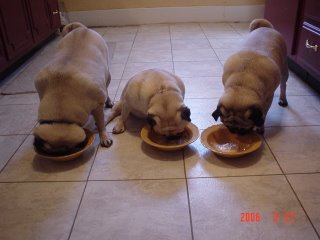We've all heard about chocolate being bad for dogs. But what else should be on the no-no list? Here's a list from the
Cold Nose News.
Thank you
Fisher at the
Wacky Weim Group on
Dogster.com for bringing this info to my attention.
Why are grapes harmful?
As far as grapes and raisins go, no one is sure why they're harmful. It's been confirmed that even grapes grown without fertilizers or pesticides can be toxic to dogs. But not to every dog, and not every time. It's also not known whether small amounts eaten over a long time period could have a cumulative effect.What we do know is that the end result in nearly all reported cases of grape or raisin toxicity is acute kidney failure. (The term "acute" means that the condition is severe and comes on quickly.)
The dog ultimately can't produce urine, which means they can't filter toxins out of their systems -- a process essential to life.During the twelve-month period in which the effects of grapes were studied, the ASPCA Animal Poison Control Center handled 140 cases involving one or more dogs. Over a third of the dogs developed symptoms ranging from vomiting to kidney failure, and seven dogs died.
The ASPCA based their study on reported cases, so naturally there may be cases where a dogs health is entirely unaffected by eating grapes. But until they know all the facts, the Society advises against feeding pets grapes or raisins in any amount. An ounce of prevention...
So, your dog just scored himself a big box of raisins or some Valentines chocolates. What's a pet owner to do?The first line of defense, if the grapes or raisins were eaten recently, is to induce vomiting and administer activated charcoal (it absorbs toxins in the GI tract). Vomiting is also the first sign that your dog is in trouble, so skip right to the activated charcoal if vomiting has already occurred. (In a pinch you can make your own activated charcoal by burning a piece of toast until it's charred and crumbles easily.) Then call your vet right away.The vet will keep your dog on intravenous fluids for at least 48 hours and monitor blood chemistry daily. Normal blood work after 3 days usually means your dog is in the clear.Keeping a watchful eye out, of course, is the best way to keep your pet out of trouble. Like children, dogs (and other pets) have a knack for getting into mischief when we're not looking.
It's Not Just the Grapes...There are other foods your dog should be kept away from, and some of them may surprise you:
Chocolate
Who can resist chocolate? Like it your not, your dog.Chocolate is made with cocoa beans and cocoa beans contain a chemical called Theobromine, which is toxic to dogs. So on Valentine's Day, you're actually being kind to your best buddy if you eat all the chocolates yourself!Read my special report on chocolate to learn more, and see how different types of chocolate have varying effects on dogs health.
Cocoa Mulch
Mulch isn't food, but there's one type tempting enough for dogs to eat. Cocoa bean shells are a by-product of chocolate production (which is how mulch made it into the "foods" category) and are popular as mulch for landscaping. Homeowners like the attractive color and scent, and the fact that the mulch breaks down into an organic fertilizer. The coca bean shells can contain from 0.2% to 3% theobromine (the toxin ) as compaired to 1-4% in unprocessed beans.
Fatty foods
Fatty foods are hard for a dog to digest and can can overtax the pancreas, leading to pancreatitis. This can threaten your dogs health and is potentially fatal.NutsMacadamia nuts should be avoided. In fact most nuts are not good for the dogs health since their high phosporus content is said to lead to bladder stones.
Onions
Onions, and especially raw onions, have been shown to trigger hemolytic anemia in dogs. (Stephen J Ettinger, D.V.M and Edward C. Fieldman, D.V.M. 's book: Textbook of Veterinary Internal Medicine vol. 2 pg 1884.) Stay away from onion powder too.
Potatoes
Potato poisonings among people and dogs are rare but have occurred. The toxin, solanine, is poorly absorbed and is only found in green sprouts (these occur in tubers exposed to sunlight) and green potato skins. This explains why incidents seldom occur. Note that cooked, mashed potatoes are fine for a dogs health, actually quite nutritious and digestible.
Artificial Sweeteners
iXylitol is used as a sweetener in many products, especially sugarless gum and candies. Ingesting large amounts of products sweetened with xylitol may cause a sudden drop in blood sugar in dogs, resulting depression, loss of coordination, and seizures. According to Dr. Eric K. Dunayer, a consulting veterinarian in clinical toxicology for the poison control center, "These signs can develop quite rapidly, at times less than 30 minutes after ingestion of the product" states Dr. Dunayer, "...therefore, it is important that pet owners seek veterinary treatment immediately."
Turkey
Turkey skin is currently thought to cause acute pancreatis in dogs, partly due to it's high fat content.
Here are the rest of the foods listed by the ASPCA as harmful:
Alcoholic beverages Avocado (the only "fatty" member of the vegetable family)
Coffee (all forms of coffee)
Moldy or spoiled foods
Salt
Yeast
dough
Garlic
The Bottom LineThanks to a more educated public, fewer fatalities from foods like chocolate are being reported these days. But it's important to keep up with what's currently known about foods and their effects on dogs health. Grapes and cocoa mulch, for example, were only discovered very recently to have harmful effects.
Check frequently with sources like the ASPCA, or sign up for the "
Cold Noses News" to have information like this delivered to your inbox. (You'll also get a bunch of cool dog stuff along with your free registration).
